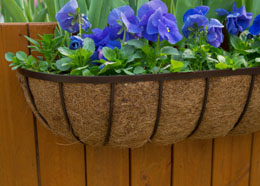Popular as houseplants, African violets thrive well indoors, and bloom throughout the year. Here are some tips to take care of this plant.

African violets are perfect for those, who want indoor plants that require less space and minimal care. These plants do not need direct sunlight for their growth, and also like the temperature settings and humidity inside homes. Apart from the traditional variety with bluish purple flowers, African violets are now available in shades like, pink, white, purple, etc. Some plants produce double layered petals too. Even though they thrive well as indoor plants, you have to take care of their basic requirements, so that they stay healthy and produce flowers throughout the year.
How to Take Care of African Violets
African violets belong to the genus
Saintpaulia in the family
Gesneriaceae. These flowering plants are native to Tanzania and the genus is named after Baron Walter von Saint Paul-lllaire, who discovered this plant in this African country. The African violet is now very popular as a houseplant, and is widely grown in most parts of the world. While African violets are considered perfect as indoor plants, proper care has to be taken, if you want them to grow healthy.
- Soil: These plants require loose, well-drained soil. You may buy some soil mix, fertilizer, and pots that are specifically meant for these plants. Otherwise, plant them in soil that contains perlite, moss, etc., for sufficient drainage.
- Sunlight: Even though African violets cannot survive in harsh sunlight, they need at least eight hours of bright light for flowering. You may either place these plants on windowsills, where they get indirect sunlight; or provide them with fluorescent lights for 16 to 18 hours a day.
- Water: Watering must be done only when the soil looks dry. Over watering can lead to mold problems and rotting. Room temperature water without softeners are good for these plants. If you want to use tap water, then keep it overnight, so that the chlorine and fluoride dissipate. Water them once in two to three days, that too if the soil looks dry. It will be better to avoid wetting the leaves. If there is excess water in the pot, you have to drain it after some time.
- Humidity and Temperature: African violets need an average humidity, and a temperature range of 63° F to 75° F. During nighttime, these plants need a slightly lower temperature. However, never place African violets near air conditioners, vents, oven, cooking range, etc.
- Feeding: Regular use of fertilizers is often recommended for African Violets. It will be better to use water soluble fertilizers that can be absorbed by the plant easily. Avoid feeding these plants during winters. However, this is not applicable for those grown in artificial light.
- Foliage Removal: You have to remove the old and yellow leaves regularly. Even dead foliage has to be removed for the proper growth of the plant.
- Repotting: When the plant overgrows the pot, repotting has to be done. It is recommended to use pots with a diameter that is one-third the entire diameter of the plant. You may also remove the suckers (as soon as they develop) to maintain the shape and size of the plant.
Mentioned above are some of the basic requirements of African violets. Adverse conditions may cause harm to this plant and you have to rectify the problem, as soon as the plant shows symptoms, like drooping leaves.






 African violets are perfect for those, who want indoor plants that require less space and minimal care. These plants do not need direct sunlight for their growth, and also like the temperature settings and humidity inside homes. Apart from the traditional variety with bluish purple flowers, African violets are now available in shades like, pink, white, purple, etc. Some plants produce double layered petals too. Even though they thrive well as indoor plants, you have to take care of their basic requirements, so that they stay healthy and produce flowers throughout the year.
African violets are perfect for those, who want indoor plants that require less space and minimal care. These plants do not need direct sunlight for their growth, and also like the temperature settings and humidity inside homes. Apart from the traditional variety with bluish purple flowers, African violets are now available in shades like, pink, white, purple, etc. Some plants produce double layered petals too. Even though they thrive well as indoor plants, you have to take care of their basic requirements, so that they stay healthy and produce flowers throughout the year.